Jamieson Self-Guided Heritage Walk

Jamieson's fascinating history has been captured in this self-guided walk. Take in the landscape, gardens, wildlife and the overall beauty. Walk past quaint cottages, heritage buildings, picturesque river settings and beautiful deciduous trees both of botanical significance and colourful spectacle. Bright green in spring and summer, and all shades of yellow, red and golden when their leaves turn in autumn.
Other highlights include St Peter's Anglican Church surrounded by 100 year old oaks and don't miss Juddy's Hut, an example of an early miners cottage. Visit "The Island" where the Jamieson and Goulburn Rivers meet - Keep your eyes open for beautiful native birds and if you're lucky you may even spot a platypus whilst riverside.
Following the discovery of alluvial gold in 1854 at Cashens Point to the south, the first signs of settlement began appearing on what was then known as Jamieson Flat.
Jamieson is said to be named after George Jamieson, a shepherd in the area in the 1850s. It was not really a gold mining town, rather a supply town. From Jamieson, supplies would be packed by horse and mule along the narrow winding tracks to the diggers on the goldfields of the Upper Goulburn.
By 1866, according to Butler's Woods Point & Gippsland General Directory, there were 12 carriers, 5 mine offices, 22 stores, 8 hotels, 2 breweries 3 restaurants and the Theatre Royale, a police station and lockup. A red brick Courthouse which held General sessions and Court of Mines. A Post and Telegraph Office had been opened along with the Union Bank, 3 schools were operating, 2 churches, a Masonic hall, 3 doctors, a chemist and a Registrar of Births, Deaths and Marriages.
The Jamieson Chronicle was being printed by Alfred Goulding with help from his young assistant, Tom Still.
Local tradesmen at this time were 4 blacksmiths, 2 saddlers, 2 bricklayers, 4 carpenters/builders, a tinsmith, a bootmaker, a wood splitter, a tailor, a sawyer, a cabinet maker, a cooper, a confectioner and a stonemason.
By the turn of century the mining boom was over after nearly 50 years. Then came WWI, the depression of the 1930s and WWII, and by the 1950s Jamieson had settled into a slower agricultural life-style. Jamieson become part of the Mansfield Shire in 1919 and today with a permanent population of less than 100 people, it has become a popular tourist destination.
The route is displayed on interpretive signs in 25 sites around the township, download online or pick up a map from the Mansfield Visitor Information Centre.
Location of Historical Sites

1 RIDGES COTTAGE
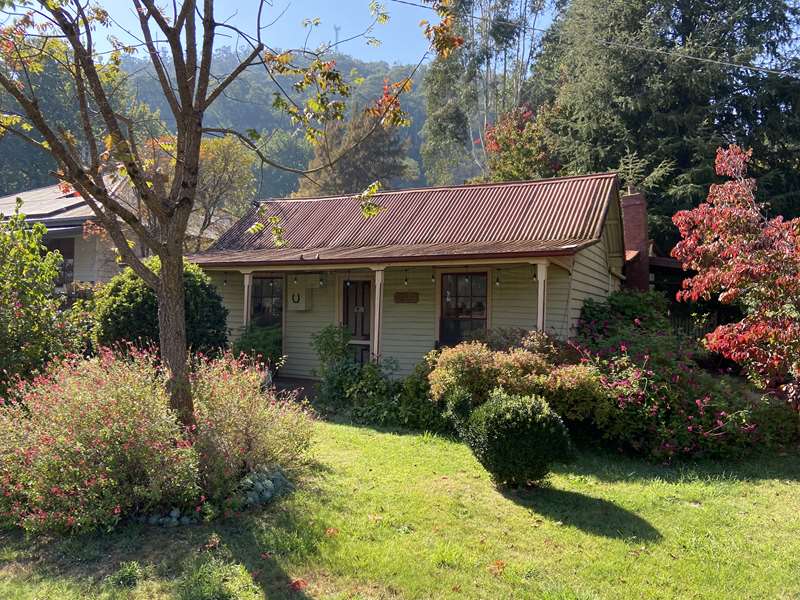
Built around 1864 by Michael Ridge, one of the towns early settlers. The Ridges served the community as Blacksmiths & Wheelwrights for over 50 years.
"The shades on the hill are coming fast
And the heat of the day has cooled at last,
The sun has disappeared before the hill,
And all the bush appears to be quite still" Joe Backledge
The original section of this cottage was built approximately in 1864 by Michael Ridge, one of the areas early settlers to the area. Michael arrived in Jamieson at the tender age of 24.
Michael and his sons served the community of Jamieson as skilled Blacksmiths & Wheelwrights for almost 50 years.
After his death in 1920, Michael's sons, John and William, carried on the business. The brick extension that can be seen today was added in 1992, and is now a private residence.
2 DIGGERS EXCHANGE HOTEL
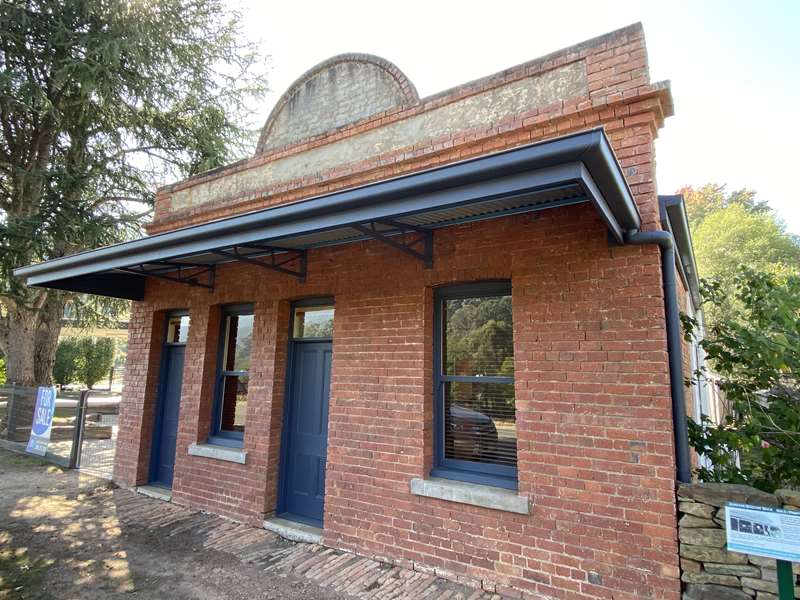
One of only three hotels still operating at the end of the 19th century, built in the late 1870's, closed by 1911.
"Pass the wine cup around, my boys,
Don't let the bottle stand there,
For tonight we'll drink the health
Of every overlander." Anon
Once one of the many busy hotels in the Jamieson township, the Diggers Exchange Hotel supplied locals with a drinking hole and a social point for many weary miners.
The Hotel was built in the late 1870s by Henry Clayton and was one of only three hotels still operating at the turn of the 20th century.
The licence was taken over in late 1899 by Edward Edwards, in 1904 by John Cole Matthews and in 1906 by George Forsayth. Robert Gray ran the hotel until it was closed by the Licence Reduction Board in 1911.
3 MATTHEWS COTTAGE
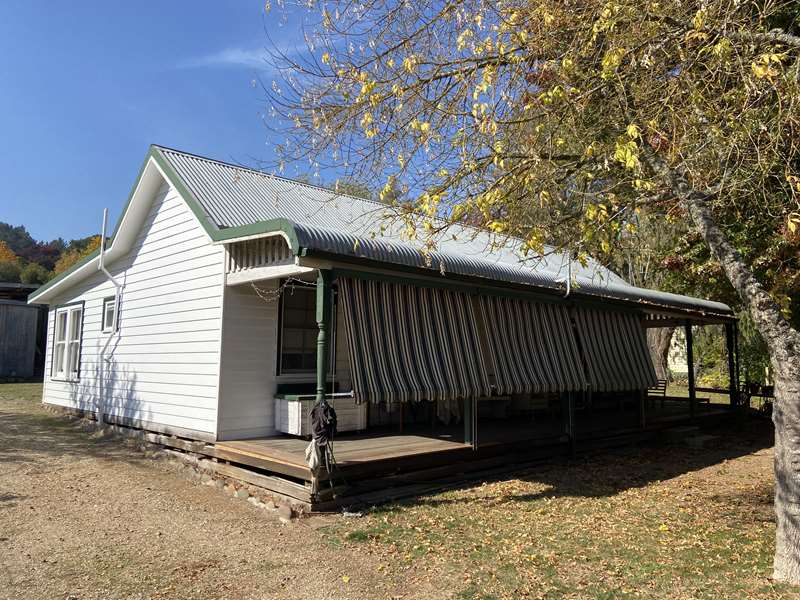
The home of John Cole Matthews, a councillor and business man who ran the coach service between Mansfield and Woodspoint from 1899-1914.
"The roads are rare to travel, and life seems all complete,
The grind of wheels on gravel, the trot of horses' feet,
The trot trot and canter, as down the spur we go,
The green sweeps to horizon's blue that call for Cobb & Co." Anon
The original section of this cottage was once the home of John Cole Matthews, another of our early settlers. He was a councillor and a businessman who ran the coach service between Mansfield and Woods Point from 1899 to 1914. The trip, which required many stops along the way to change horses, consisted of a six hour journey from Mansfield to Jamieson with an overnight stop at the Junction Hotel, then a further seven hours to Woods Point departing at 4:00am the next day. Charges for this monumental trip, which today would take less than two hours by motorcar, were 4/- (40c) to Jamieson or 30/- ($3) to Woods Point including accommodation.
Descendants of John Cole Matthews still live in the cottage today.
4 OLD COLONIAL BANK
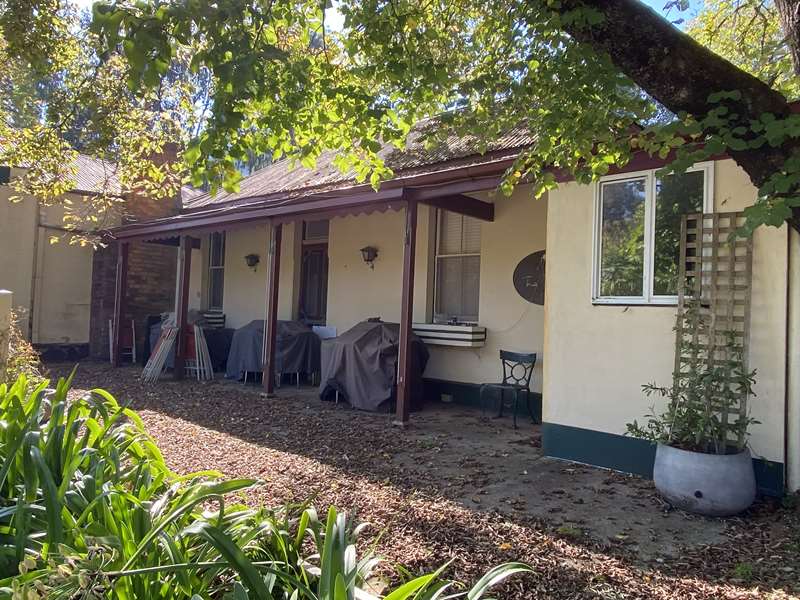
Originally built in 1867 as the Colonial Bonk and managers residence for the first Bank manager Edwin Fitzroy Lusignon.
"At the old Junction pub they were playing pool,
The blacksmith was shoeing a cocky's horse
Next door the butcher was cutting up the meat,
Couple old miners walking down the street" Anon
In 1868, this was the site of the Colonial Bank and manager's residence. Edwin Fitzroy Lusignan was the first Bank Manager, a position he held for 18 years. He was a much respected man and when he moved to Benalla in 1885, a dinner was held in his honour at the Junction Hotel where he was presented with 50 guineas ($105).
In 1925, the Jamieson Branch closed and business was transferred to Mansfield. The building then became a storeroom and extra accommodation for the Junction Hotel next door. Between 1948-52, the building was used a residence for the publican's family and when the hotel burnt down in January 1961, the building was used as a temporary bar.
When the last licensee, Mrs Dorothy Denholme, surrendered the 104 year old licence in 1965, it was transferred to the Lakeside Hotel (Jamieson Brewery).
5 TOWNSEND'S COTTAGE
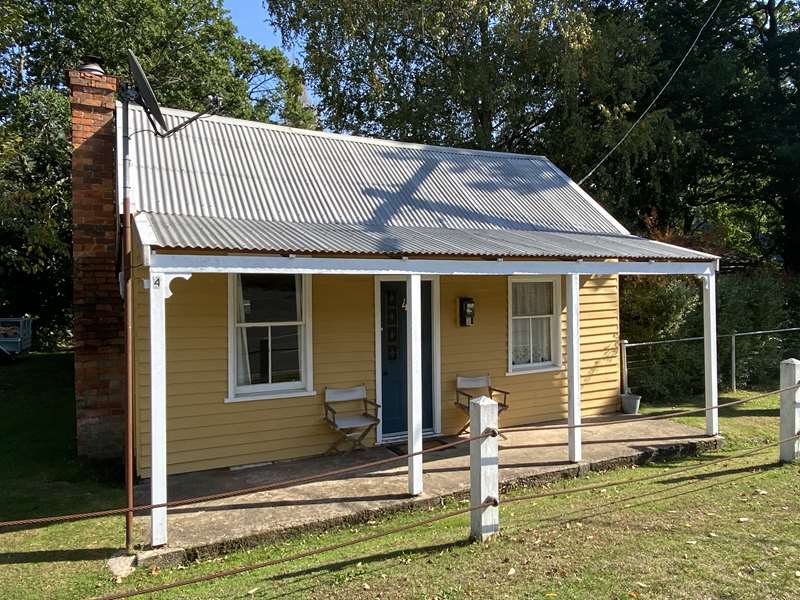
One of the towns original buildings, it was the butchers residence, the butchers shop was located next door.
"She'd buy the few things that she did need,
Flour and sugar and bread, to make a feed,
Old Charlie used to run the butcher's shop,
Most the day up the pub he'd prop." Poem by Joe Blackledge
One of Jamieson's original buildings, this was the butcher's residence. The butcher and baker shop were once located next door and operated until the 1950s. The last butcher was Charlie Sutcliffe.
6 HIBERNIAN BREWERY SITE
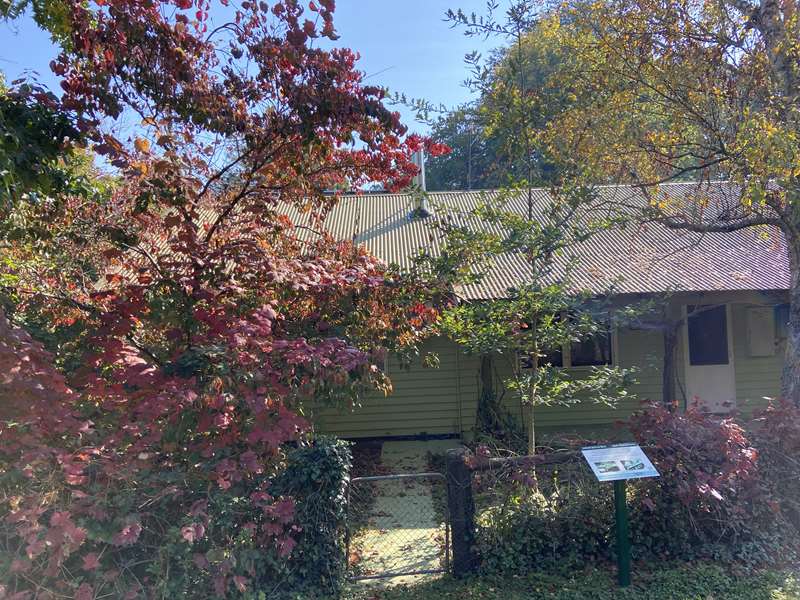
The Hibernian Brewery built in 1862 by Daniel Finn, was situated on the North Bank of the Jamieson River.
"The morning star has vanished, the frost and fog are gone,
In one of those grand mornings which but on mountains dawn,
A flask of friendly whisky, each other's hopes we share,
And throw our top-coats open to drink the mountain air". Author Anon
The Hibernian Brewery, built by Daniel Finn in 1862, was situated on the north bank of the Jamieson River. It was one of two breweries in Jamieson in the 1800s (the other was the Goulburn Brewery on the Jamieson River opposite the end of Perkins St). The Hibernian Brewery was later known as the Alpine Brewery.
7 FINNS BRIDGE
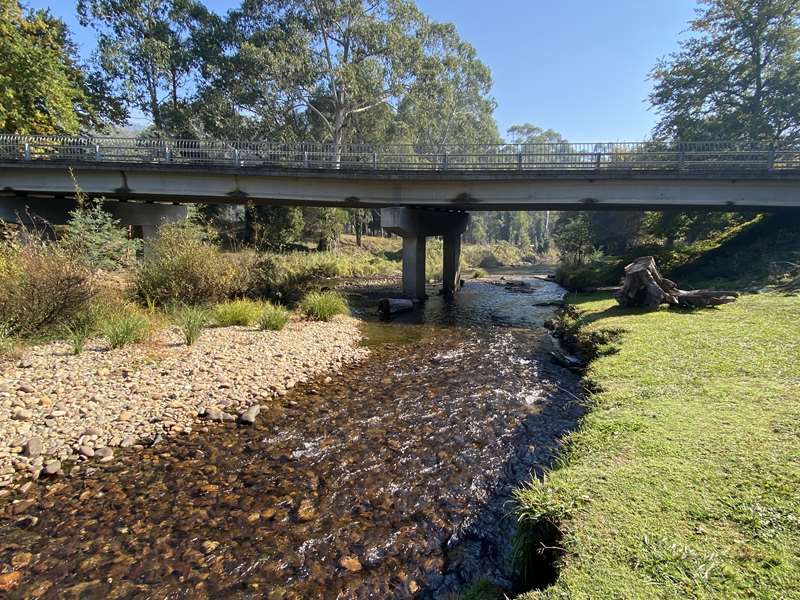
The first bridge was a toll bridge built by Daniel Finn in the 1860's, over the years several bridges have been destroyed by floods. The new bridge opened in 1990 and was renamed Foots Bridge.
"When you get near the town with a little frown,
You wonder if the bridge will carry your weight,
As you approach, the each of you slow right down,
You apply your brakes and change all gears,
For this bridge has been here for many long years." Joe Blackledge
Now known as Foots' or Jamieson Bridge, the original crossing was built and owned by Daniel Finn of the Hibernian Brewery. He charged a toll for the public to use it. The council continued to charge tolls when they took over the maintenance of the bridge.
In 1873 council paid Mr Finn 25 pounds from rates on the condition he, "re-open the bridge to the public immediately". Several bridges have been erected here, most being destroyed by floods. The present bridge, built at a cost of $850,000, was officially opened in December 1990.
8 THE ISLAND
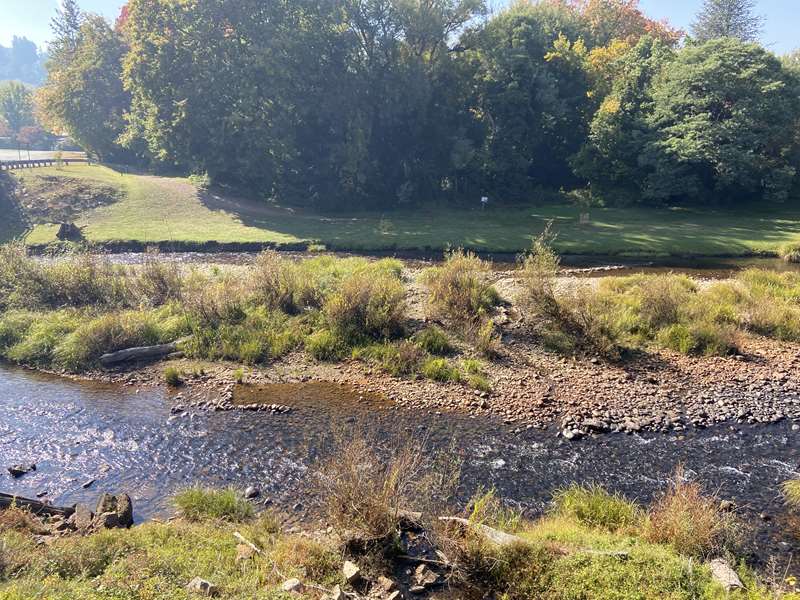
Where the Jamieson and Goulburn Rivers meet. Fruit trees planted in the 1860's by Dr. Nash still remain.
"Where the rivers meet, clean and swift,
And trout are abundant and wary,
It is here they like to drift,
Up to the mountains where the water is deep." Joe Blackledge
The meeting point of the Jamieson and Goulburn rivers can be quite a spectacular sight in winter or spring when the rivers are running high. On the other hand, it's a great picnic spot in the summer.
The land once belonged to Dr Andrew Nash, Jamieson's first doctor, and apple trees from his orchard are still growing here. The Island as it was once known, is now on public land.
Once over-grown with blackberries, The Island has been cleaned up and over 300 native trees have been planted by the local community.
9 JUDDY'S HUT
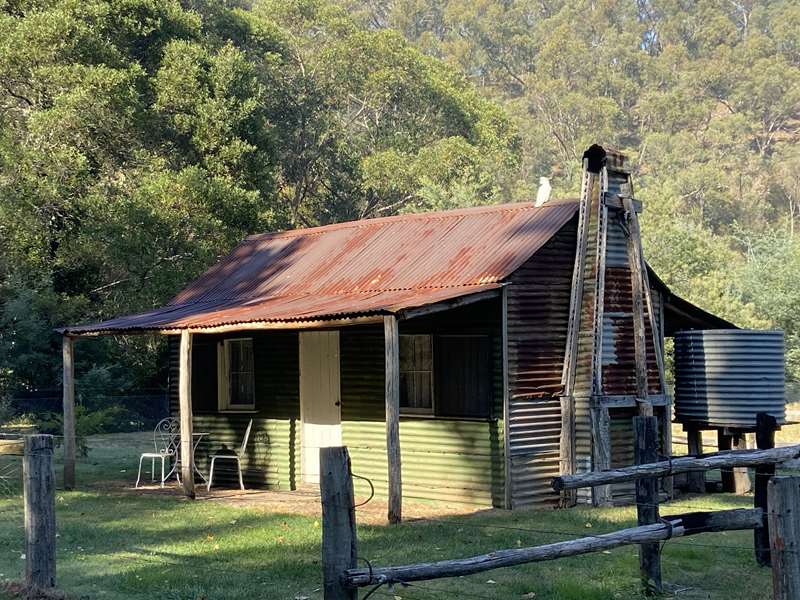
An example of an early miners cottage, it was built in 1933 by miner Bill "Darkie" Herbert, and is named for WW1 Veteran "Juddy " Hampton who lived here during the 1950's.
Stand up, my young Australian,
In the brave light of sun,
And hear how freedom's battle,
Was in the old days lost - and - won." Anon
A good example of an early miner's cottage, this but is named after Jack "Juddy" Hampton, a well known Jamieson identity. In 1917 at Paschendaele, Belgium, he was bayoneted in the stomach by a Frenchman who, in the dawn light, mistook him for the enemy. Primitive medical facilities meant that he was crudely stitched up and repatriated to Australia. Being a tough bird he survived the attack, with the scar to prove it.
The hut itself was built in 1933 by miner Bill "Darkie" Herbert from various salvaged materials including from the house that burnt down on this site.
In the 1950s Juddy moved into this cottage when his hut near Gooley's Bridge was flooded by the new Eildon Lake. He remained here into his 80's, before moving to a returned serviceman's home at Maldon where he died in 1983 aged 95.
10 POLICE STABLES
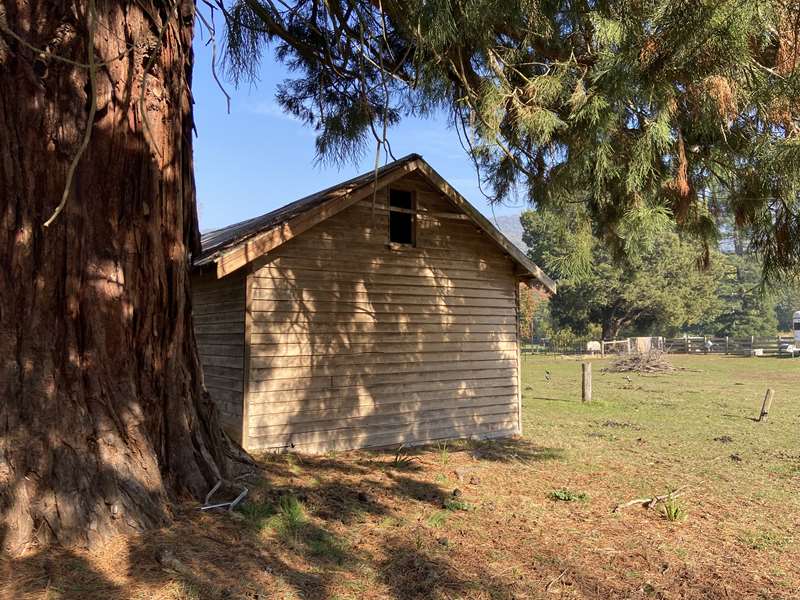
These stables were built in 1862 as part of the original police camp.
"The tyrants of the Goldfields,
Would not let us live in peace,
They harried us and chased us,
with their horse and foot police." Anon
These original police stables were built in 1862 and consisted of carriage storage area, feeding stalls, feed storage and harness room. The stables were part of the original Jamieson police camp that also included a cook-house, sleeping quarters for mounted police and a sergeant's quarters which were of slab and shingle construction. There was also a solid log and shingle lockup. In 1866 four police officers were stationed here -two foot constables and two mounted troupers - under the control of Sgt Barber. They met the needs of the large population of gold miners in the area.
The four Giant Sequoias on this block were planted in the 1860s and are believed to have been part of a consignment of trees supplied by Ferdinand von Mueller, the explorer and botanist, who established the Melbourne Botanic Gardens. Two were felled in 2010 because of disease, one of which fell onto the stables - hence the newer timbers and roof section.
11 McQUILTEN'S COTTAGE

Originally located at Ten Mile on Sailor Bill's Creek, built in the 1890s, it was re-located after the 1939 bushfires.
It leapt across the flowing streams,
And raced o'er pastures broad;
It climbed the trees and lit the boughs;
And through the scrub it roared;
The bees fell stifled in the smoke,
Or perished in their hives,
And, with the stock, the kangaroos,
Went flying for their lives. Henry Lawson
The cottage was built by Martin McQuilten in approximately 1903 on the Sailor Bills Creek, at the township of Ten Mile. Martin and his second wife Gretta, raised seven children in this small, four room home. A separate large kitchen was off an "L" shaped verandah at the rear. Out-buildings included laundry, wood shed, stable/buggy shed and fowl house.
On the 13th January 1939, Black Friday bushfires razed most of Ten Mile, including McQuilten cottage's out-buildings. Heroically, the main house was saved and later the same year, transported to Jamieson to be re-built including kitchen and laundry. The McQuilten family lived here until 1945 when it was sold to Mr W. Kendall for 900 pounds ($1800).
In 1987, a great grandson of Martin McQuilten purchased the cottage. During restoration work, singe marks were found on the back of some of the original weather boards, showing how close it was to being lost to the Black Friday Fires. The McQuilten Cottage continues to be enjoyed and cared for by Martin and Gretta's descendants, and will be a part of their heritage in the future.
12 BREWERY BRIDGE
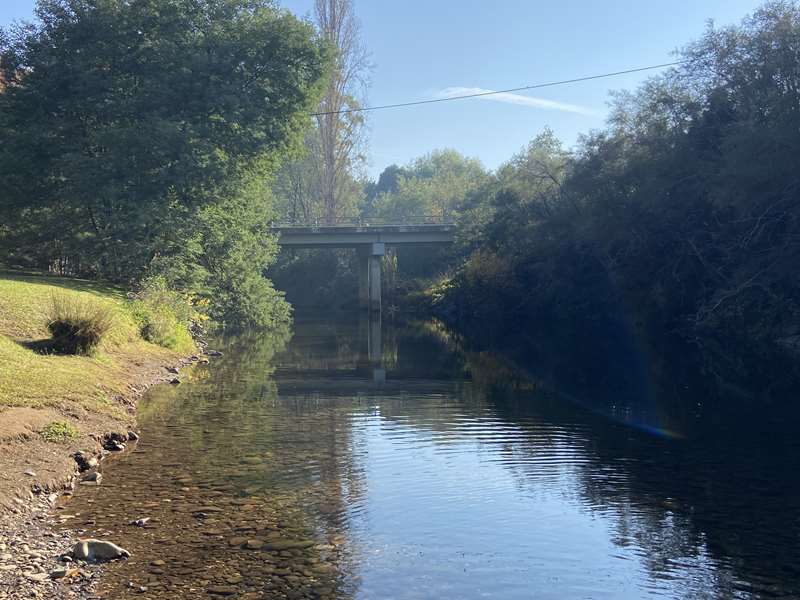
Named for the Goulburn Brewery built in 1864 by William Grene Power, which once stood downstream.
"Where the Jamieson River runs below,
As we drove further into town it began to unfold,
The scenery here was something to behold,
Almost a wild west town,
I had been told." Joe Blackledge
The original Chenery Street Bridge, later known as Brewery Bridge, is now simply known as the Licola Bridge. The Brewery name referred to the Goulburn Brewery, which once stood opposite the end of Perkins Street.
The Goulburn Brewery was built in 1864 by William Grene Power and purchased in 1875 by Richard Dale. The brewery was quite a concern, with "horseworks, a pump, 2 malt mills, cold and hot water tanks, a mash tun, sparger, a copper of 51/2 hogs heads and other paraphernalia, including 200 casks and a 5 room brewery cottage". After Richard Dale's death, the Goulburn Brewery changed hands several times and finally closed about 1901.
The Original bridge was washed away in 1870. Its replacement survived until 1995 when the current bridge was opened.
Definitions: 'Mash Tun' - An insulated chamber where grains and water are mixed. 'Sparger' - Distributes gases in liquids, i.e. aerates. 'Hogs Heads'- Barrel
13 CEMETERY

Here you will find headstones marking the final resting place of some of the area's early settlers and pioneers.
"And the bush hath friends to meet him, and kindly voices greet him,
In the murmur of the breezes and rivers on its bars,
And he sees the vision splendid of the sunlit plains extended,
And at night the wondrous glory of the everlasting stars." A.B. 'Banjo' Paterson
Here you will find headstones marking the final resting place of the area's early settlers and pioneers. Among the graves you will find: Herman Berger and his son Alexander, the Ridge family, the Allen family of Ten Mile, Alfred Hobday, Richard Dale, McCormack, McQuilton, Foots, Hoskins, Wheeler, Mountford, Peterson and Gerrans families, just to name a few.
Many of the names are still to be heard in the district today carried by the decendents of these men and women.
HEADSTONES TO LOOK FOR:
John Martin 1864 - The earliest recorded headstone, transferred from the old cemetery once located next to the school.
The Brosnan Family - Ancestors of former Pentridge Padre Father John Brosnan
Edward Allen - Father of Tom Allen Born 25-4-1788, Died 8-5-1888 (14 days off age 100)
Loy Yim - Died 2-6-1906 aged 77, the only reminder of the Chinese who lived, worked and died in the district.
14 JAMIESON PRIMARY SCHOOL

Common school 814 was officially recognised on 24th September 1865. The building we see here today was completed on January 9th 1878.
"We think of all days passed on,
And try to retrieve our childhood times,
Of all the goods things had in the past,
Some of these will forever last," Joe Blackledge
Common School No.814 was officially recognised on 24th September 1865 and government aid awarded. The class was held by Andrew Loughrey, with an enrolment of 51 pupils. When Mr Loughrey left the district in April 1867, the school was closed until a new teacher arrived in August 1867. The original school, built on the south-eastern corner of the block was an 18x30 foot, one room, timber building with a shingle roof and brick chimney. It was completed on 16th September 1867 at a cost of 150 pounds ($300). In 1868, a 20 foot extension was added at a cost of 60 pounds ($120).
The pupil roll was growing and in 1871, a gallery and tiered seating was approved. By 1873 Mr John Dunkerly, with only his wife Hannah to assist him, was teaching 121 pupils and desperately needed more space. On 24th October 1876, a price of 112 pounds ($224) was accepted from Dodson & Co. of Mansfield for a brick building, with a galvanised roof, to accommodate 150 pupils - to be completed by 17th May 1877.
Unfortunately, part of the Jamieson Primary school building was re-erected on the adjoining old cemetery ground, forcing the school to apply to use the rest of the grounds of the cemetery. The building was completed on 19 January 1878.
The original old timber building was dismantled in 1882 and rebuilt on the Gerrans property as Jamieson East School 2499, to cater for the families further up the Jamieson valley. Mr John Bennett would teach there throughout the nine years of its existence.
When the school closed, the Gerrans family were forced to buy back the land they had donated for the school. A far cry from the boom days, Jamieson PS 814 reflected the decline of the town as attendance dropped off.
The pupil roll today averages 20 students with two full-time teachers. Jamieson 814, now in the 21st century, is no longer disadvantaged by the distance or lack of facilities, as was the case in the earlier days. Television and video in the classroom, pupils working with computers, excursions to Melbourne, Mt Buller and Canberra, things not even dreamt of back then. A time capsule was placed at the school in 1985 as part of Victoria's 125th Anniversary Celebrations, to be opened in the year 2035. "I wonder how future generations will view this little school in the bush.
15 SCHOOL RESIDENCE
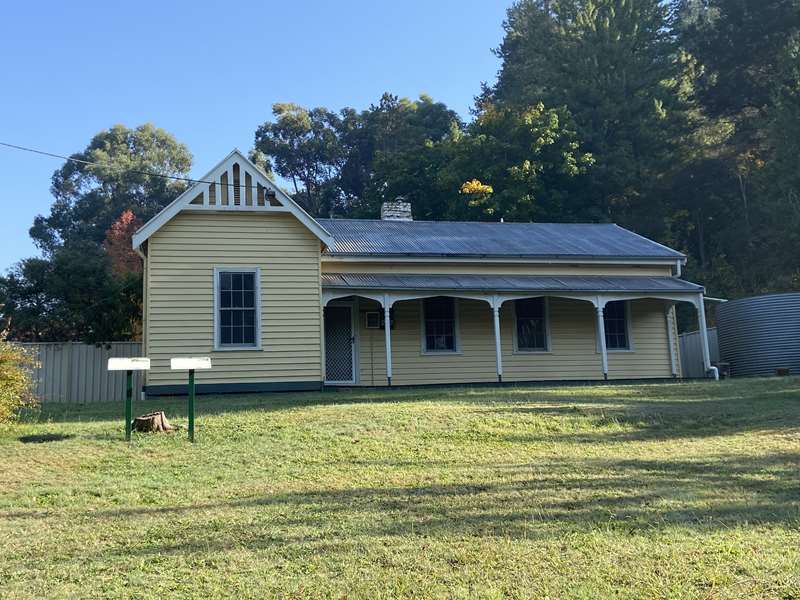
In the 1860's accommodation for teachers was not a priority. A school house was first requested in 1877. Finally begun in 1888 the residence we see today was not completed until 1944.
"The winter had set in and the house was cold,
The old brick chimney was covered in mould,
We scrounged some wood and lit old iron stove,
Shoved on the black kettle to make a brew." - Joe Blackledge
Accommodation for teachers was not a high priority in the 1860s when teachers were expected to find their own accommodation in private homes or hotels. The first request for a school residence was made in 1877. However the Education Department was only prepared to spend 150 pounds ($300), so work was postponed. In 1883 Mr Webb's submission for a three room dwelling was also unsuccessful. By 1888 the head teacher was Mr Ullyett. His request for school accommodation was met by a Department suggestion that the school be partitioned to provide living quarters. He refused this unsatisfactory offer and eventually the Department approved the building of a one room residence.
Mr Ullyett then requested an additional two rooms as he had a large household including his wife, seven children and a housekeeper. He was informed that he would have to finance any extra accommodation himself. Meanwhile the private house that he was renting was being sold from under him.
The residence was finally completed in April 1891, but Mr Ullyett had been granted a transfer in 1892. The empty house became uninhabitable by 1897. When Mr Haslam arrived in 1900 with his wife and four children, his request for a two room extension was approved and completed by early 1902. In 1909 Mr. Frank Wood took over and requested a wash-house and bathroom: "The washing is being done in kerosene tins in the kitchen; it is too wet to light up outside"
With no bath of any kind, Mr Wood requested that the veranda be partitioned to form a bathroom. His request was denied as funds were only available for urgent works.
In 1944, there was still no bathroom or laundry and the only cooking facility was the open fire. After the last water tank collapsed, Mr Wood was forced to cart water from the river in a cream can for his pregnant wife and four children. The Education Department advised "there are no funds for such work"
In 1945, despite having no bathroom, the Department decided that the house be plastered and rent increased. Mr Stocks, then head teacher, refused to pay extra rent until he was given the basics. The Department finally complied. Electricity was connected in 1955 at cost of 104 pounds ($208),
16 ARBORETUM
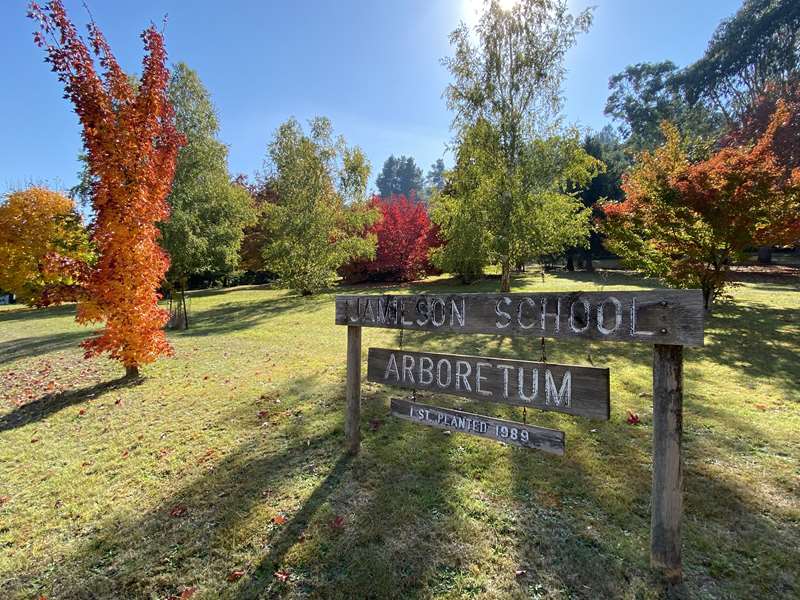
A combined effort of the Jamieson community, it was planted in 1989 on the old pine plantation site, to become a picturesque addition to the town.
"The blackbirds whistling their merry tune,
White backed magpies warbled in the trees,
The thrush was gathering grubs for his young,
The lyrebirds mimicking all the sounds." Joe Blackledge
Jamieson School (No.814) has had some keen and energetic teachers over the years.
Among them was Frank Wood, head teacher in 1910, who planted a magnificent garden at his own expense, including a range of bulbs, plants and shrubs and over 200 varieties of roses.
Mr Bavington started a plantation of Walnut trees in 1925 but they were unsuccessful.
When local resident Padge Seymour became head teacher in 1927, he replaced the walnut trees with 100 pines. These pines were harvested in the 1960s.
The Arboretum, a combined effort of the Jamieson community, was planted on the old plantation site in 1989 so that it might become a picturesque addition to the town in future years.
17 MOUNTFORD COTTAGE
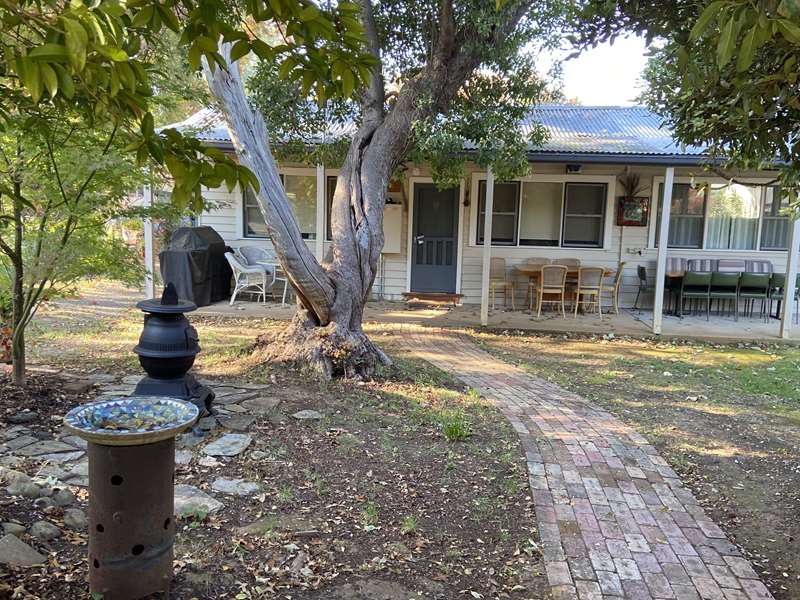
Once the residence of Charles William Mountford, who owned the Mountain Brewery and Cordial Factory at Raspberry Creek.
"Here we decided to set up house,
Up on the hill where the green grass glows,"
And the river runs white with melted snows,"
As time passed on we settled in the airy old shack." Author Anon
This early cottage was the residence of another pioneer family of the district - the Mountfords.
Charles Mountford owned the Mountain Brewery and Cordial factory at Raspberry Creek near Gaffneys Creek. He was very involved in community affairs, serving as a member of the Howqua District Road Board in 1869 and as a Magistrate at Gaffneys Creek. He retired to Jamieson a few years before his death in 1894.
His grandson, Charles William (Bill), was a brewer at the Goulburn Brewery. Bill's younger brother, Avelyn, was a veteran of WWI. He served in France with 1st Australian Imperial Force 3rd Pioneers and was wounded at Amiens, Northern France in 1918. During WWII, he served as a member of the home forces.
18 SIBERIA
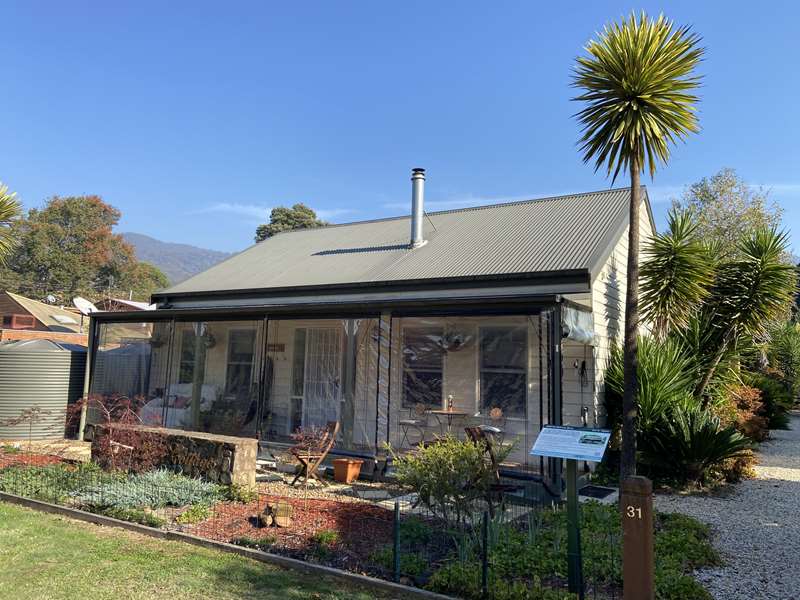
On this site once stood a quaint cottage built early in the 20th Century, as extra accommodation for the Courthouse Hotel.
"The new generation has now taken over,
And most of the oldies have gone undercover,
The next generation has already stepped in,
And Saturday nights have already stepped in." Author Anon
This was the original site of "The Cottage", built around the turn of the 20th century by Bill Dole, at the rear of the Courthouse Hotel as extra accommodation for the hotel. At times it also housed inebriated customers "to sleep it off". That's how the cottage became known as "Siberia".
During the 1920s, Siberia served as a Church of England manse (residence) for Father Tyler and later for Father Charles Deverell.
In about 1930, the building was dismantled and moved to this site, where it became home to Elsie Murphy, the hotel housemaid for many years. The cottage was demolished in 2008 to make way for the house you see today.
19 ST JOHN'S CATHOLIC CHURCH
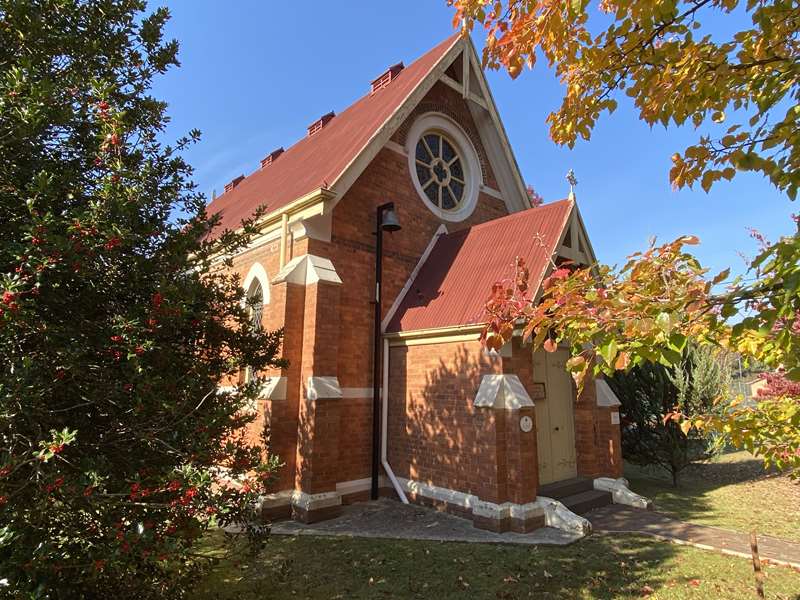
The first church was small timber chapel erected, to the left of the current site. The present building was opened in 1900.
"The sun is hidden by the clouds in sky,
The wintry days are slowly slipping by,
And spring is here to greet the morn,
The warm sunny days have been reborn." Author Anon
Father Patrick Kavanagh was the first Priest for the Parish which covered the district from Mansfield to Jericho. This hard-working priest travelled to Woods Point each week conducting mass at all the tiny settlements along the way.
It was Father Kavanagh who organised the land for the Jamieson church to be built on. It was gazetted in 1863 and the first building was a small timber chapel erected to the left of the current site. Father Patrick Courtney became St John's first Priest and blacksmith Michael Ridge was the first trustee. The present building was built at the turn of the 20th century from hand made bricks manufactured in Mansfield.
20 JAMIESON COURTHOUSE
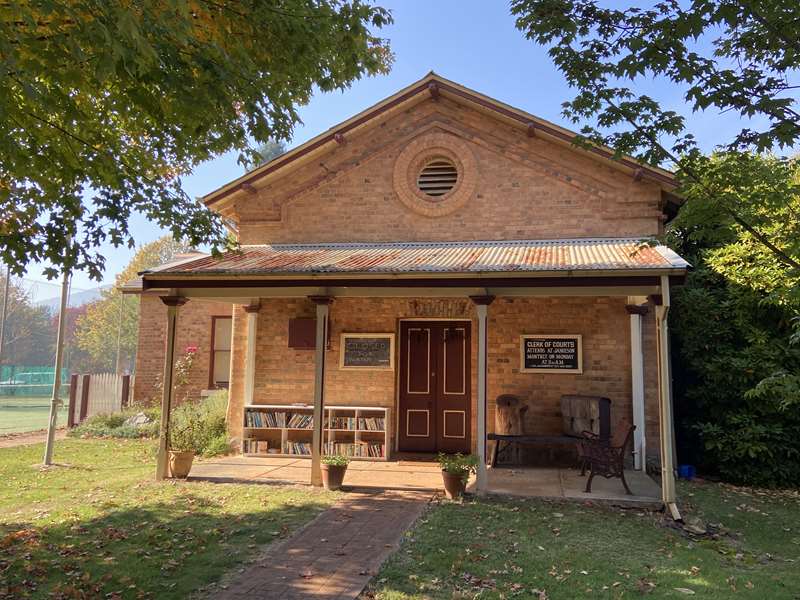
Built in 1864 of local hand made bricks, the building served as a County Court, Court of Mines, and Court of Petty Sessions.
Built in 1864 for the thriving Upper Goulburn Goldfields, the Courthouse signalled the arrival of law and order in the district. Designed by H.A.Williams, a draftsman for the Public Works Department, it was built of hand made bricks from the Jamieson Brick Company on a sandstone base with a slate roof. It served as County Court, Court of Mines & Court of Petty Sessions until 1977.
The Court heard its last two cases in 1974. One was an inquiry into the death of a worker on the Thomson Dam, the other into a fatality resulting from a car accident on the Woods Point Road.
The land was gazetted as a Public Building Extension in 1959. After a public outcry over the possible sale and demolition in the 1980s, it was gazetted as an Historic Building Reserve. It was then leased by the Jamieson Community Group to be restored for use by the town. Having taken over the Courthouse in 1991, the Historical Society raised and spent over $60,000 on restoration.
Now the headquarters of the Jamieson & District Historical Society, it contains a Museum and archives and is open to the public on weekends/public holidays from November to Easter. It also houses a local Health Centre and Clinic.
21 COURTHOUSE HOTEL
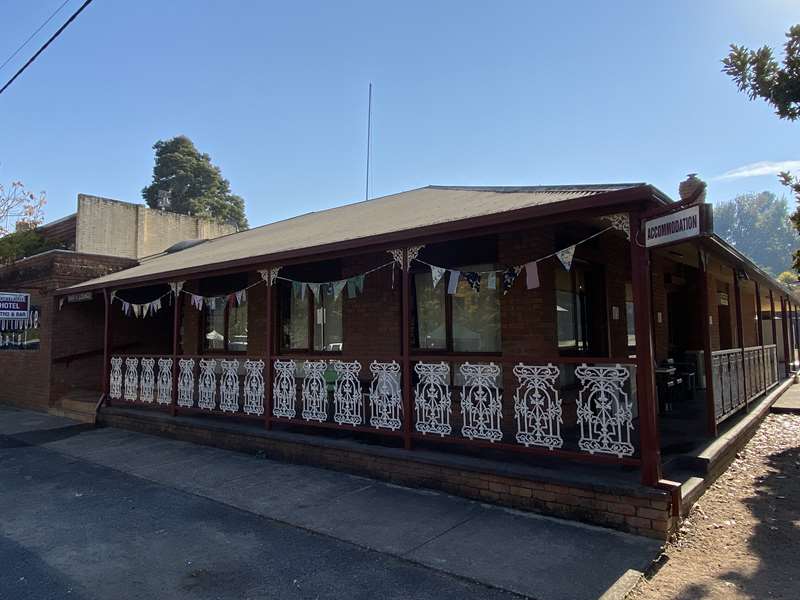
The original hotel, built in 1861 was a shingle roofed, double storey, timber building. Between 1886 & 1900 the building was bricked and a verandah added, it burnt to the ground in 1982.
We've drunk our wine, we've kissed our girls,
and funds are sinking low,
horses must be thinking it's a fair thing now to go."
Sling the swags on Condamine and strap the billies fast,
And stuff a bottle in the bags and lets be off at last." Author Anon
Coker and Kelson's Courthouse Hotel, the original hotel, was a shingle-roofed, double storey, weatherboard building, with 16 bedrooms, two parlours, lounge, dining room and a large hall.
The hotel, store (Kelson Smith & Co) and Theatre Royale were built by Isaac Kelson in 1864. In 1878, Richard Dale purchased the hotel from John Lowther for 161 pounds ($323). Richard had purchased the Goulburn Brewery in 1875. A community spirited man, he served many terms on the shire council and also as district magistrate for many years. When he died in 1894 aged 56, his wife Mary Ann took over the running of the Hotel. She was the state's oldest licenced victualler when she passed the licence to her daughter Annie in 1946. Annie ran the hotel until it left the Dale Family after more than 60 years of ownership.
In early 1982, as the last operating hotel from the 1860s, a fire destroyed the building. Graham and Rose Bakker, licensees at the time, rebuilt the hotel with the original bricks and wrought iron. The original lamp still hangs outside the hotel.
Definition: 'Victualler' - a person who is licensed to sell alcohol
21a MAGNOLIA GRANDIFLORA

This beautiful tree has survived since the 1860s. It is believed to be part of the shipment of trees mentioned in letters from Baron Ferdinand von Mueller to Jamieson Police between 1863 and 1865, when Sergeant Henry Baber was in charge of the Police Reserve.
The late John Fogarty, head of Mansfield Shire Parks & Gardens, suggested that the high ground level at the base of the Magnolia Grandiflora gave credence to the age of the tree. Over the many years, the gravel road surface was lowered by grading, leaving the tree back at ground level.
The tree is remarkable for surviving many trying times, including the Courthouse Hotel fire in 1982. At Jamieson's 150th anniversary in 2011, another Magnolia was planted in Gerrans Reserve.
Baron Ferdinand von Mueller (1825-1896) was a distinguished botanist and explorer, founder of National Herbarium of Victoria and Director of Melbourne Botanic Gardens from 1857-1873. As Government Botanist from 1853, he examined Victoria's flora, especially the unknown Alpine vegetation of the Upper Goulburn area. As a member of the infamous Acclimatisation Society, von Mueller promoted the introduction of the blackberry, now a noxious weed. It is said that he always planted blackberry seeds in the ashes of his campfires.
21b JAMIESON CHRONICLE

In the 1860s, Alfred Goulding established his printing business on this site and, in 1862, the first edition of the JAMIESON CHRONICLE was published here. When Alfred passed away in 1876, his assistant Tom Still took over. Tom Snr (and later his son Tom Jnr) continued publishing the newspaper, which has kept the district informed for over 50 years.
The last JAMIESON CHRONICLE was published in 1916. By the 1940s, the building was little more than an old shed in the main street. In the 1960s, it was demolished to make way for what is now the residential section of the Courthouse Hotel.
In 1878, Tom Still printed the 2,000 pound WANTED posters for the capture of the Kelly Gang on this printing press. Today, only two known originals of the poster remain. One is held at the Old Melbourne Gaol and the other is owned by the Jamieson & District Historical Society Inc.
22 POST OFFICE
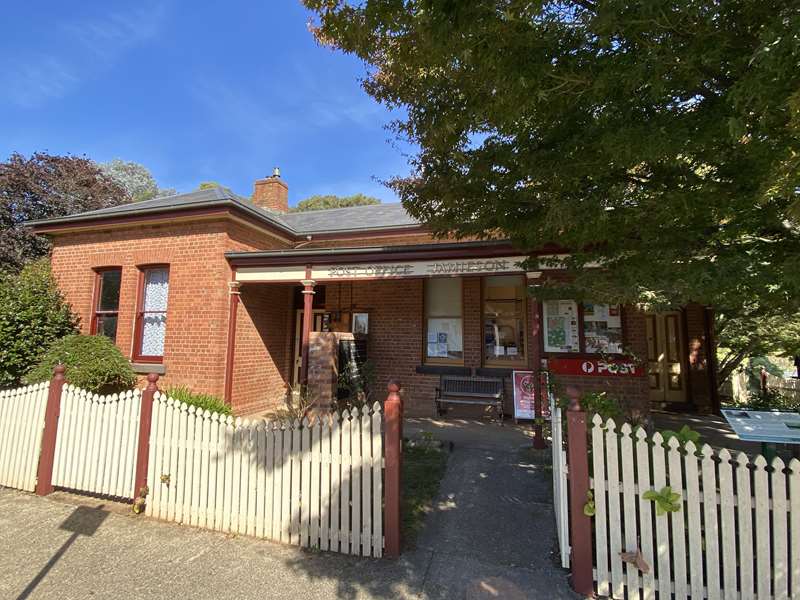
The present building was built of hand made bricks in 1872, and was opened for business soon after.
The original Post and Telegraph Office was on the lower side of Bank Street (Woods Point Road). When the Oriental Bank closed in 1865, Postmaster Robert Kennedy moved the Post Office to the old bank building. The Jamieson Chronicle of June 1868 tells us that the Post Office and Telegraph Station had already moved and was "adjacent to the Courthouse Hotel".
The present Post Office building was built in 1872 and has housed the Jamieson Post Office ever since. The telephone was connected in the late 1890s making the Telegraph obsolete.
One of the old Oppenheimer telegraph poles is now used as the flag pole in the grounds of the Museum.
The single wire party-line from Mansfield to Woods Point remained in service until after WWII. June Mason was Telephonist until the 1970s, when the exchange was automated, and was Jamieson's best known Postmistress. She succeeded her Aunt, Gladys Wray, in 1954 and held the position for 30 years until her retirement in 1984.
23 MEMORIAL HALL
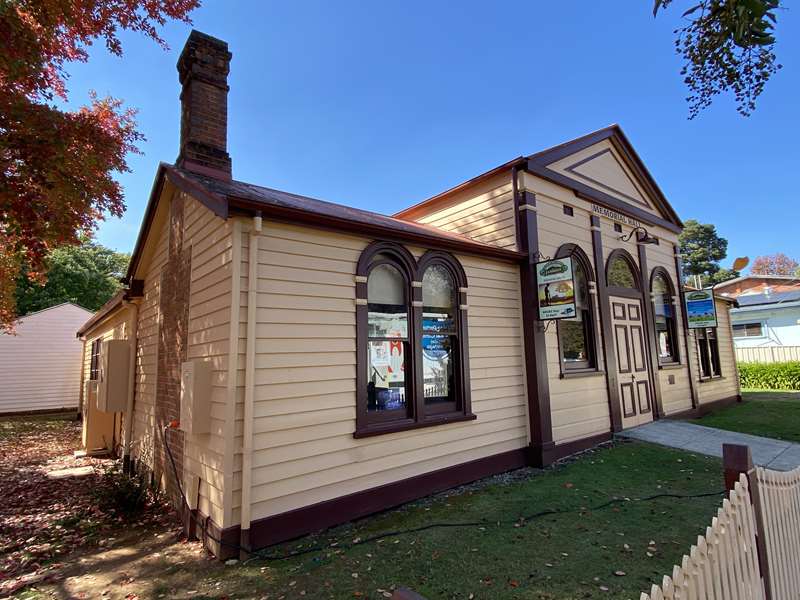
Used as the Howqua Shire Offices until amalgamation with Mansfield in 1919, the building was donated to the town as a memorial to Jamieson's WWI veterans.
"Whatever fun is going on, the stockmen will be there,
Be it theatre or concert, or dance or fancy fair,
To join in the amusements to be sure he won't delay,
For the stockmen of Australia, lighthearted boys are they." Author Anon
Following a Grand Opening Ball in 1883, this building was used as the Town Hall and Howqua Shire Offices until amalgamation with Mansfield in 1919. The building was then turned over to the people of Jamieson as a memorial to those who fought in WWI. The annual Anzac Day Service is still held here each year.
The Hall was also home to the Prince of Wales Lodge from 1865-1912 and the Jamieson Free library in the 1890s.
The Memorial Hall has served as a venue for countless dances, parties and community events over the years, and is the community meeting place in time of flood and fire.
24 WYWURRI
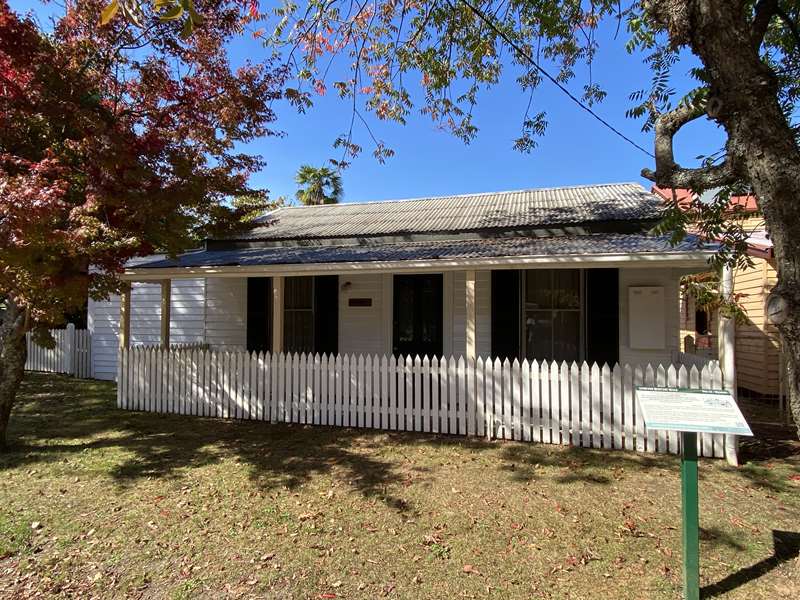
The original 1860s building is of pole type construction with canvas walls, typical of many early buildings.
" The but was made of the surface mud,
the roof of a ready thatch,
The doors and windows open flew without a bolt or latch,
The pigs and geese were in the hut, the hen on the table flew,
And she laid an egg in the old tin plate for the stringy-bark cockatoo." Author Anon
The original building, dating from around the 1860s, was a pole type construction with canvas walls and dirt floor, typical of many of the early Jamieson buildings. At one time, it was used as the grain store for the Courthouse Hotel.
"Wywurri" had been the home of Rev. Charles Deverell. and Lil Stuart. Lil, the daughter of Mary Ann & Charles Bullbrook Mitchell, was one of Jamieson's earliest residents. Lil was orphaned at an early age and was raised by her eldest sister, Mary Ann Dale of the Courthouse Hotel.
Over the last 100 years, the building was restored and a mud brick extension added. Ellen McRae and Jacqui Bate operated a restaurant here for a few years.
25 ST PETER'S ANGLICAN CHURCH
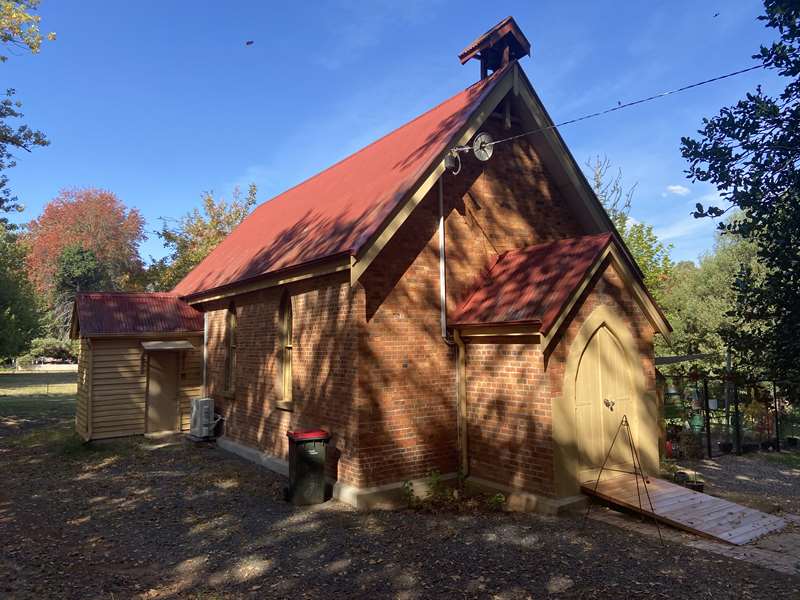
Surrounded by 100 year old oaks, this beautiful old church was inaugurated on September 28th 1865.
'The stars shine through the clouds at night,
The moon moving steadily like soft bright lights,
Travelling onwards across the sky leaving a shadow on the ground,
Moving slowly to the west and homeward bound.' Author Anon
Surrounded by 100 year old oaks, sycamores and pines, this beautiful old church was inaugurated on 28th September 1865 with full Masonic honours. The first Rector was Rev Frederick Smith, who came to the parish in April 1865.
The main structure was built of local handmade bricks with a shingle roof, now covered by galvanised iron for protection. The porch and wooden vestry were added at a later date.
The interior roof beams are extremely solid and the pulpit is hand carved Lebanon Cedar.
Photos:
Location
7 Chenery Street, Jamieson 3723 View Map
Web Links
→ Jamieson Heritage Self-guided Walk Brochure (PDF)








